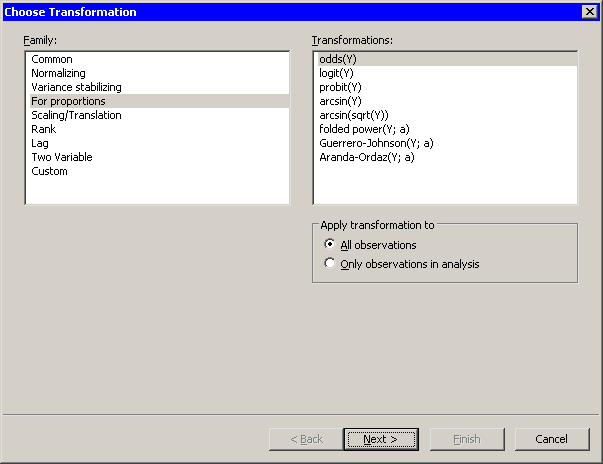Variable Transformations
Figure 32.14 shows the transformations that are available when you select from the list. These transformations are intended for variables that represent proportions. That is, the Y variable must take values between 0 and 1. You can also use these transformations for percentages if you first divide the percentages by 100.
Chapter 7 of Atkinson (1985) is devoted to transformations of proportions. Equations for these transformations are given in Table 32.4.
Table 32.4: Description of Transformations for Proportions ![]()
|
Default |
Name of |
||
|---|---|---|---|
|
Transformation |
Parameter |
New Variable |
Equation |
|
odds(Y) |
Odds_Y |
|
|
|
logit(Y) |
Logit_Y |
|
|
|
probit(Y) |
Probit_Y |
|
|
|
arcsin(Y) |
Arcsin_Y |
|
|
|
arcsin(sqrt(Y)) |
Angular_Y |
|
|
|
folded power(Y;a) |
MLE |
FPow_Y |
See text. |
|
Guerrero-Johnson(Y;a) |
MLE |
GJ_Y |
See text. |
|
Aranda-Ordaz(Y;a) |
MLE |
AO_Y |
See text. |
The probit function is the quantile function of the standard normal distribution.
The last three transformations in the list are similar to the Box-Cox transformation described in the section Normalizing Transformations. The parameter for each transformation is in the unit interval: ![]() . Typically, you choose a parameter that maximizes (or nearly maximizes) a log-likelihood function.
. Typically, you choose a parameter that maximizes (or nearly maximizes) a log-likelihood function.
The log-likelihood function is defined as follows. Let N be the number of nonmissing values, and let ![]() be the geometric mean function. Each transformation has a corresponding normalized transformation
be the geometric mean function. Each transformation has a corresponding normalized transformation ![]() , to be defined later. Define
, to be defined later. Define
and define the log-likelihood function as
The following sections define the normalized transformation for the folded power, Guerrero-Johnson, and Aranda-Ordaz transformations.
In each section, ![]() .
.
